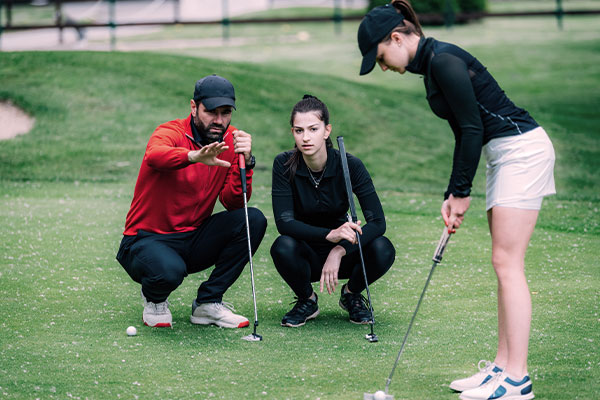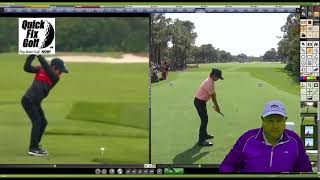By Bobby Lopez, PGA Professional
Yes I’m a football fan. Although I must admit I’m disgusted with the salary caps, free agency
and the musical chairs played with trades these days.
First my apologies to anyone who is NOT a football fan but here’s the analogy. In football you’re permitted four plays or opportunities to gain ten yards down field against your opponent. If you
surpass the ten yard minimum you maintain possession of the football and continue to attempt an
additional ten yards until you reach the goal line or end zone.
I use the football analogy to play a little game in my mind in hopes of building up confidence in converting what is potentially a bogey into a par or maybe birdie! Here’s my method.
First Down Play – Applying football to golf….your tee shot is the first down play. If you’re second down and twenty all day you’re NOT going to win the football game. That’s why it’s vitally important to have a properly fitted driver. A properly fitted driver will be fitted for accuracy NOT distance. You need to find a way to control your tee shots and position them in the fairway with the BEST angle to approach the green. With a tee shot right down the middle I would consider the second shot a second down and 5 play. A tee shot in the woods would be a second down and 15.
Second Down Play – Your iron approach to the green is important however a poorly played second down play will NOT kill your round of golf. Sure hitting the green in regulation gives you your best opportunity to make a par but there are no pictures on the scorecard if you make your par from off the putting surface.
Third Down Play – Your chip shot, lob shot or bunker shot is a third down play that you MUST convert, (get up on the green and make the putt) in order to lower golf scores. Even the best golfers on tour only hit about 60% of their greens in regulation so touring pros are getting up and down, (scoring a par from off the green) more than you might think. Get the ball in the hole off the green for potentially a two shot swing! You were headed for bogey and made birdie!
I like to classify the difficulty of a third down play by yardage. For instance, if you’re right on
the front edge of the green with a straight uphill chip shot with plenty of green to work with and
you’re using a low lofted golf club, (a 6 or 7 iron) I consider myself a third and two. You should convert
most of the time from third and two or three. I would consider it a third and twenty when you’re ball is behind a bunker forcing you to elevate the golf ball with a high lofted golf club needing to stop the ball on a dime. Not much chance of converting for a first down in this situation. Learn to play conservative in these situations and not take a big number. Better to clear the bunker even if you leave yourself a long putt back to the hole then to dump the ball or “chile dip” it and leave yourself a fourth and twenty!
Using Lower Loft – The lower the loft you can use the better your chances for success. Arnold Palmer once said, “my best chip is as good as my worst putt.” Does this suggest that you should always chip with your putter? Not at all! Of course if conditions permit, (short firm grass between your ball and the putting surface) get out your putter and go for it.
The Four Big Keys to Successful Chipping. To be successful on third down plays or chipping you need to dominate three different facets of chipping:
1) The Chipping Stroke
2) Your Alignment
3) Your Choice of Landing Area
4) Your Choice in Loft or Golf Club
1) The Chipping Stroke – To get a feel for the chipping stroke try taking a three wood and gripping it very low on the shaft and holding the butt of the golf club up against your front forearm. This drill will help you develop a pendulum stroke with limited motion with the hands and help you avoid flipping your hands at impact which is a destroyer of the chipping stroke. Flipping not only adds loft at impact lifting the golf ball higher than expected but the flipping also closes the golf club face at impact pulling the golf ball to the left of the target.
2) Your Alignment – I suggest building yourself a hitting station to chip from when practicing. You can use golf clubs or the very popular “snow poles” to make a box aligned to your target. I witness sloppy alignment when teaching chipping. It appears that golfers understand the importance of aligning a putt and neglect the same careful attention when chipping.
The process I follow is: Make sure the leading edge of your golf club is facing directly at your target landing area. Most golfers leave the club face open or to the right for right handed golfers. You might find that if you leave your club face open you are probably doing the same with your full iron shots as well. Your eye has become accustomed to the look of the open club face so that the club face does NOT look open to you at address when chipping.
3) Your Choice of Landing Area – It is to your advantage to use the least amount of loft possible when chipping. Loft equals speed! If you want the ball to roll faster use less loft. The further you are away from your landing area to more loft you need to slow the ball down. Loft or arc will affect how fast the ball travels on the putting surface.
4) Your Choice in Loft or Golf Club – The best way to improve your decisions in loft and roll speed is to practice. Find a practice chipping or putting green and work your way around the green chipping from different angles. Chip with a six iron from about three yards off the green. Hit the ball so it flies in the air to about a foot or so on the green and watch it roll the rest of the way. Observe the roll and build a database of situations in your mind so you recognize the similar situation when it presents itself on the golf course. Try chipping from the same position with an eight iron with the same amount of force to reach your identical landing area chosen for the six iron. Notice how the ball will not have sufficient speed to reach the hole. Then move about three yards further back from the green and landing area and try the
same shot again with the eight iron. You’ll find that the eight iron from further back will roll at the same SPEED that the six iron did from closer to the target or landing area.
Bottom line when it comes to short game is, the better you become at judging distance and ball speed the more successful you will be.
Bobby Lopez, PGA



